ISSN ONLINE(2278-8875) PRINT (2320-3765)
ISSN ONLINE(2278-8875) PRINT (2320-3765)
Mrs.Seema Deoghare1, Aditya Satvekar2, Nitin Bhoye2 and Chintan Shah2
|
| Related article at Pubmed, Scholar Google |
Visit for more related articles at International Journal of Advanced Research in Electrical, Electronics and Instrumentation Engineering
In the image processing technology, noise is the major part which degrades the quality of Image. Noise will create an error in the image, So we have to make such a system which reduces the noise or eliminate the noise. In digital image several types of noise are present. For elimination of these noise we requires a filter. For different noise we have to use different filters. But the problem will arises when a image contain lots of noise present (Ex: Salt & pepper noise, Gaussian noise) then we can’t use these filters. So we have to make a universal filter/Algorithm which de-noises the image. In our propose system we are using “M-Universal Hidden Markov Tree” algorithm we propose a new image de-noising algorithm, called M-uHMT. It is simple and effective. Simulation results show that the proposed M-uHMT can achieve the state-of-the-art image de-noising performance at the low computational complexity. The proposed algorithm has two major steps: an optimum estimation of the wavelet coefficients based on the uHMT model and an averaging of the de-noised images. Each step contributes to improvement in de-noising performance.
Keywords |
| M-uHMT, Wavelet coefficient, multiple wavelet transform, De-noising, Walsh Hadamard transform. |
INTRODUCTION |
| We are aware of different filters which are used for detecting noise like Salt and Pepper noise, Gaussian noise, Poisson noise. We are also aware of different filters which only filter these noises. Practically we don’t have techniques to filter out complete noise in the digital image. So to remove this problem we have conceptualised a algorithm/filter which produces standard results. We are going to implement noise filter by using M-uHMT algorithm. This would be a universal filter. In this model we are using discrete wavelet transform to calculate image coefficient for detail processing. |
LITERATURE SURVEY |
| In our literature survey we have not come across any system which offers this kind of flexibility for de-noising of image. This was the inspiration which made us to take this as our BE project. So naturally we started to search available system in market. |
| While scanning we come across various papers related to image de-noising. From that we come to know that for denoising the image we have to use a filter only. For example: To remove Salt and Pepper noise we have to use median filter, to remove Gaussian noise we have to use average filter, to remove Poisson noise we have to use wiener filter, to remove speckle noise we have to use mean filter. We also come across different IEEE papers like: “Efficient image denoising methods based on a new adaptive wavelet packet thresholding function “by Abdolhossein Fathi and Ahmad Reza Naghsh-Nilchi. It uses wavelet thresholding. “Image de-noising via sparse and redundant representation over learned dictionaries” by Michael Elad and Michal Aharon. “Image de-noising by sparse 3D transform domain collaboration” by Kostadin Dabov, Alessandro Foi.We have taken this idea from paper “Image de-noising based on multiple wavelet representations and universal hidden markov tree |
 |
| Basis functions of the wavelet transform (WT) are small waves located in different times. They are obtained using scaling and translation of a scaling function and wavelet function. Therefore, the WT is localized in both time and frequency. We compress the image up to second iteration i.e. DWT2. |
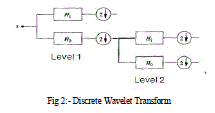 |
| The Coefficients of Hadamard Transform are all +1 or -1.The Hadamard Transform can therefore be reduced to addition and subtraction operations (no division or multiplication) this allows us to simply calculate the transform. so the speed may be the desirable aspect of the Hadamard transform. Here we are taking walsh–Hadamard transform (WHT) to de-correlate the wavelet coefficients. As a result, the task of joint estimation of (y1,y2) reduces to two individual estimation problems which are easy to solve. De-correlation of wavelet coefficients using Walsh hadamard transform (z1,z2) =WHT(y1,y2). |
| Where, |
 |
| 3) M-uHMT image De-noising Model |
| Though analysing, we combining the multiple wavelet representations with universal hidden Markov tree (uHMT) and obtain a new image de-noising algorithm which we call it M-uHMT. It provides the excellent de-noising performance for the Lena image. uHMT estimation of (z1 ,z2 ) results in ( q1, q2). |
| Following Figure shows how the image is recognized by this algorithm. Using Trellis Representation it shows a resulted image. Consider Sj is the pixel and S1,S2….Si are the hidden values of that pixel. During iterations it calculates the probabilities. For S1=a1j , S2=a2j ,….Si=aij. |
| The pixel which contains more probability is selected and copied to that position and this followed for all pixels In the image. Number of iteration shows more enhanced result of image. and finally calculated the peak signal to noise ratio(PSNR). |
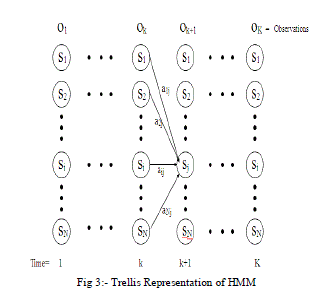 |
| 4) Inverse Walsh Hadamard Transform |
| Performing the inverse WHT results in the de-noised wavelet coefficients (v1,v2) =IWHT ( q1,q2 ) |
| 5) Inverse Discrete Wavelet Transform |
| Performing the inverse wavelet transformation results in the two de-noised images (s1 , s2) .The final de-noised image is given by taking the average of the two images(s1,s2). |
SOFTWARE DESIGN |
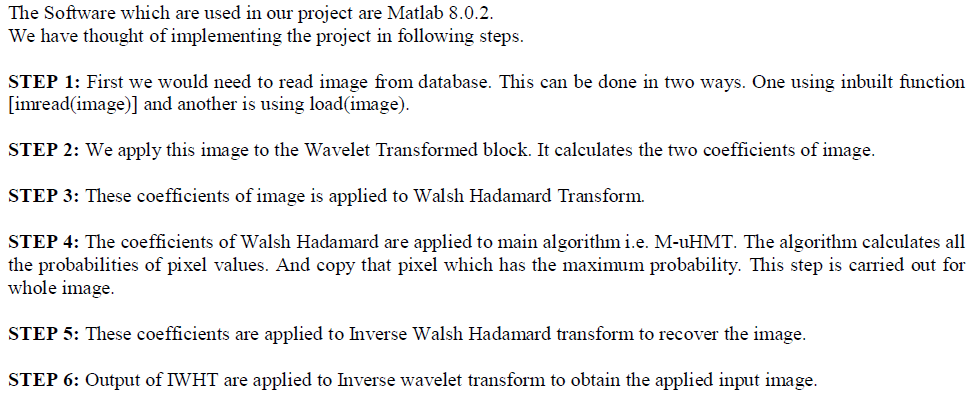 |
RESULTS AND DISCUSSION |
| HMT FOR 1D SIGNAL: |
| Figure 5.5.a shows a original Doppler signal which we have taken as a input signal. Figure 5.5.b shows a random noise added in input signal. Figure 5.5.c shows a wavelet transformed noisy signal. And figure 5.5.d. shows original Doppler signal after HMT.here using 1D signal we observed the effect of noise on signal and final de-noised output of original image. |
 |
 |
 |
 |
| DWT for 2D Signal: |
| Figure 8 shows Simulation result of DWT for 2D signal. figure 5.6.a shows the Lena as a standard input image for Ease of processing; figure 5.6.b shows that noise added in the Lena image, in this image the low filter shows the maximum information in the image. After the simulation we get results for DWT1 and DWT2 shown the first and second iteration in 5.6.c and 5.6.d respectively. |
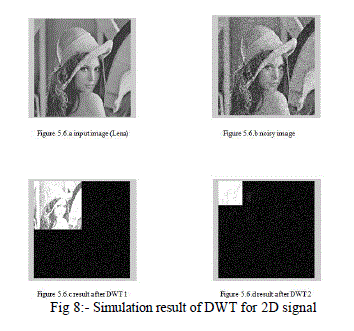 |
FINAL RESULTS |
| Figure 9 shows the Lena as a standard input image and noise added in the Lena image. After the simulation we get results for final de-noised image. |
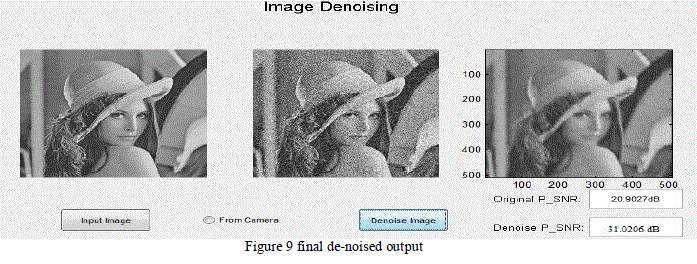 |
| From final results the PSNR value of the original image and noisy image is 20 db. The observed image from the M-uHMT model having PSNR value is 31 db. From these results we concluded that image is De-noised Following table shows the PSNR (db) result for several de-noising algorithms of Lena images, our result shows the PSNR value of 31 db which shows near Values of the results from the table. |
 |
CONCLUSION |
| We specify an HMT model for a large class of real world images, eliminating any need for training and thus greatly simplifying processing algorithms and allowing real time implementations. Adding the multiple wavelet representations which have excellent performance in image de-noising, the simulation results shows that the proposed M-uHMT can achieve the state-of-the-art image de-noising performance at the low computational complexity. |
References |
|